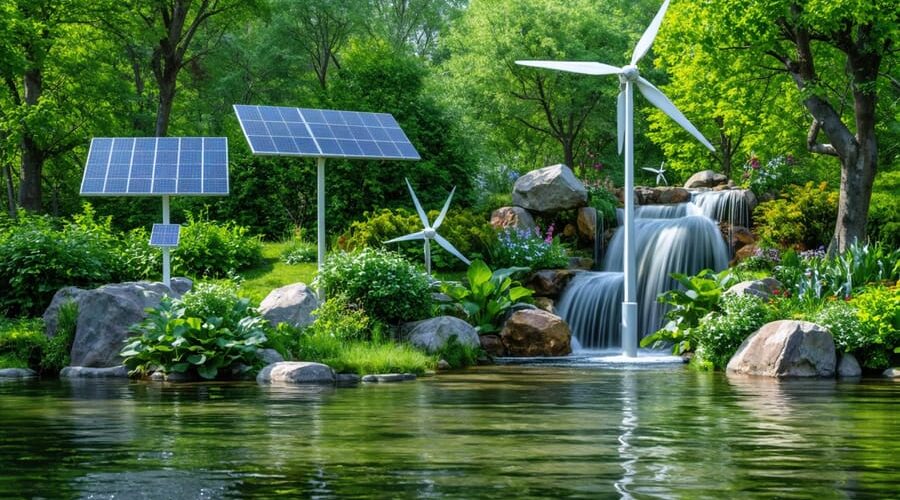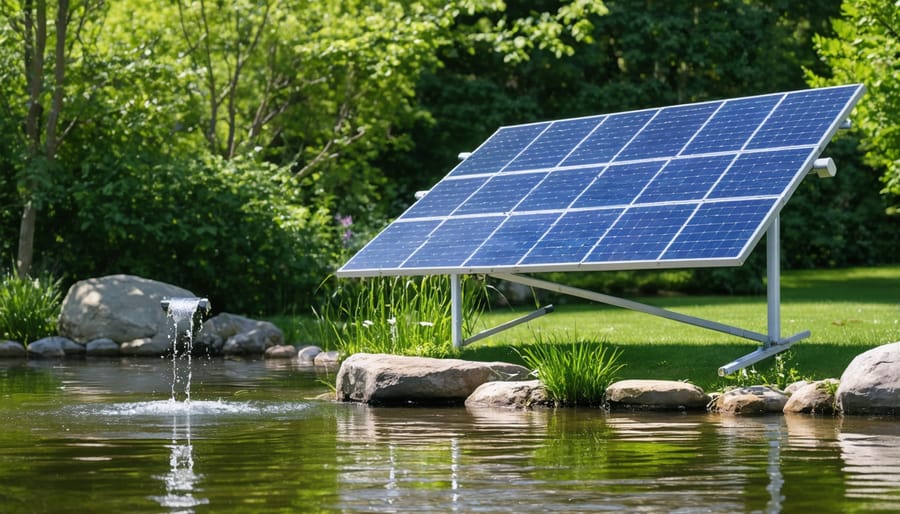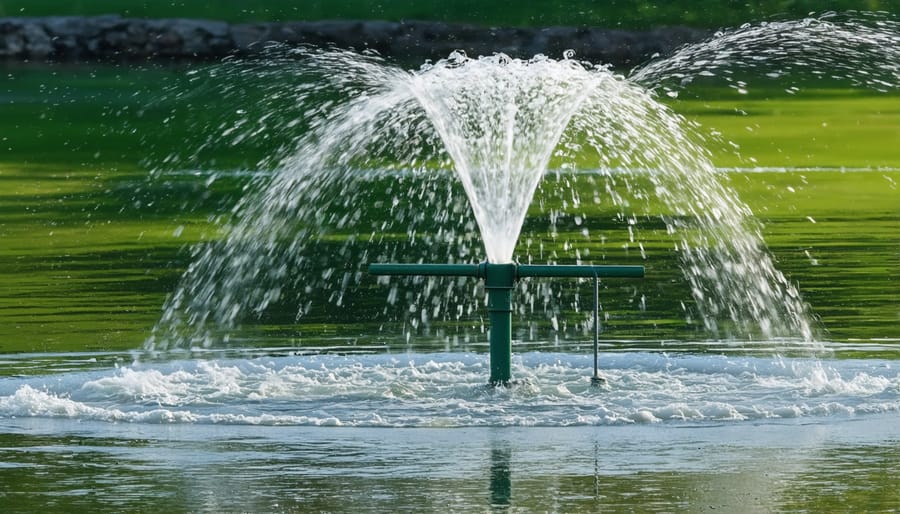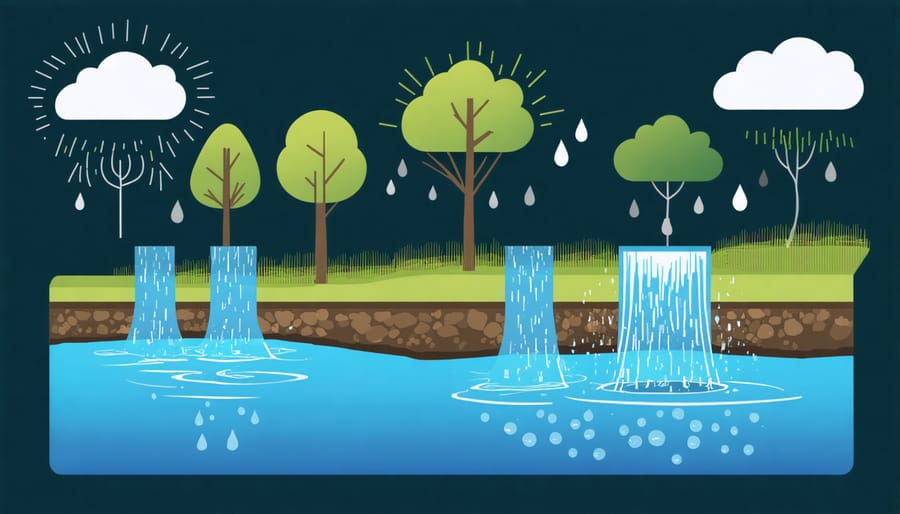
Power Your Pond Naturally: Smart Solar Solutions That Actually Work
Transform your outdoor space into a sustainable oasis with environmentally friendly pond solutions powered by renewable energy. From solar-powered pumps to wind turbines, renewable energy sources are revolutionizing how we maintain our water features while reducing both environmental impact and utility costs.
Today’s renewable technologies make it easier than ever to harness nature’s power for your pond’s needs. Solar panels can drive aerators and filtration systems during daylight hours, while small-scale wind generators provide consistent power even after sunset. Hydroelectric micro-turbines can turn your waterfall into a power generator, creating a self-sustaining ecosystem that’s both beautiful and functional.
Whether you’re building a new pond or upgrading an existing one, integrating renewable energy systems not only cuts operating costs but also ensures your water feature remains a thriving habitat regardless of grid power availability. These sustainable solutions offer practical alternatives that align perfectly with the growing movement toward eco-conscious outdoor living spaces.
Let’s explore five proven renewable energy sources that can transform your pond into a self-sufficient, environmentally responsible feature while maintaining optimal water quality and circulation.
Solar Power: The Perfect Match for Pond Systems

Solar-Powered Pond Pumps
Solar-powered pond pumps are an eco-friendly solution that harnesses the sun’s energy to keep your pond water moving and healthy. These systems typically consist of solar panels, a pump, and sometimes a battery backup for cloudy days or nighttime operation.
The most common types include direct solar pumps, which work only when the sun shines, and battery-backed systems that provide consistent operation around the clock. For smaller ponds, a simple floating solar fountain pump can add beautiful movement to your water feature while helping to aerate the surface. Larger ponds might benefit from submersible solar pumps that can move thousands of gallons per hour.
One of the biggest advantages of solar pond pumps is their cost-effectiveness over time. While the initial investment might be higher than traditional electric pumps, you’ll save money on electricity bills and enjoy virtually maintenance-free operation. Plus, installation is usually straightforward – just position your solar panel in a sunny spot and connect it to your pump.
These pumps are particularly useful in remote locations where running electrical lines would be difficult or expensive. They’re also completely safe, with no risk of electrical accidents near water, making them perfect for family gardens and public spaces. During peak sunlight hours, they operate at maximum efficiency, which coincides perfectly with when ponds need the most circulation to prevent algae growth and maintain oxygen levels.
Solar Lighting Solutions
Solar lighting solutions offer an elegant and eco-friendly way to illuminate your pond while harnessing the sun’s free energy. These systems typically consist of solar panels, rechargeable batteries, and LED lights that can create stunning effects on your water feature after dark.
For pond owners, floating solar lights are particularly popular as they require no complex installation. Simply place them on the water’s surface, and they’ll bob gently while collecting sunlight during the day and automatically illuminating at dusk. Submersible solar lights, on the other hand, can be positioned underwater to create magical effects and highlight specific features like fountains or aquatic plants.
Solar-powered spotlights installed around the pond’s edge offer more focused illumination and can be adjusted to highlight specific areas or create dramatic shadows. These typically come with stakes for easy ground installation and adjustable heads for precise positioning.
The latest solar lighting technology includes smart features like motion sensors, color-changing capabilities, and automatic timing systems. Many modern units also include high-capacity batteries that can store enough power to keep your pond illuminated for several cloudy days.
When choosing solar lights for your pond, consider factors like local weather patterns, desired brightness levels, and the specific areas you want to illuminate. For best results, position solar panels where they’ll receive maximum sunlight exposure, and clean them periodically to maintain optimal charging efficiency.

Wind Energy for Pond Aeration
Wind-powered aerators offer an eco-friendly and cost-effective solution for maintaining healthy oxygen levels in your pond without relying on grid electricity. These systems harness the natural power of wind to create continuous water movement and oxygenation, making them particularly valuable for remote locations or areas with unreliable power supplies.
The concept is beautifully simple: wind energy turns a turbine mounted above the pond, which powers an underwater diffuser through a direct-drive system. As the wind blows, air is pumped through the diffuser, creating thousands of tiny bubbles that rise to the surface. This process not only adds vital oxygen to the water but also creates beneficial circulation patterns that help distribute nutrients and maintain consistent temperatures throughout your pond.
One of the biggest advantages of wind-powered aerators is their ability to work 24/7, provided there’s sufficient wind. Most models start operating in winds as low as 5 mph, with optimal performance in 8-12 mph winds. To ensure consistent aeration during calm periods, many pond owners combine wind systems with solar-powered backup units.
Installation is relatively straightforward, typically involving mounting the wind turbine on a pole or tower near the pond’s edge. The height of the mount is crucial – generally, the turbine should be positioned at least 15-20 feet above any surrounding obstacles to catch clean, unobstructed wind flow. Most systems come with weighted diffusers that sit at the bottom of your pond, connected to the turbine via flexible airline tubing.
Maintenance requirements are minimal, usually limited to occasional checks of the airline connections and cleaning of the diffuser. The absence of electrical components means fewer parts that can fail, and many systems can operate for years with proper care. For optimal performance, consider installing multiple smaller units rather than one large system, as this provides better coverage and ensures continued aeration even if one unit requires maintenance.
Remember to position your wind aerator where it won’t be an eyesore but can still catch plenty of wind. Many models come in neutral colors that blend well with natural surroundings, making them a practical and aesthetically pleasing addition to your pond ecosystem.
Micro-Hydro Power Generation
Micro-hydro power generation offers an innovative way to harness the natural energy of flowing water in your pond or water feature. Unlike large-scale hydroelectric dams, these compact systems can generate electricity from even modest water flows, making them perfect for energy-efficient water features and sustainable pond management.
The concept is beautifully simple: water flowing downward through your waterfall or stream turns a small turbine, converting kinetic energy into electrical power. This electricity can then be used to run pond pumps, lights, or even contribute to your home’s power supply. The best part? Once installed, these systems provide continuous power as long as water keeps flowing.
For DIY pond enthusiasts, installing a micro-hydro system can be a rewarding project. Start by identifying a suitable location with a consistent water flow and sufficient head height (the vertical distance water falls). Even a modest 2-3 foot drop can generate useful power when properly designed. Many pond owners incorporate these systems into existing waterfall features, maximizing both aesthetic appeal and energy production.
The key components you’ll need include a water intake system, penstock (pipe that carries water to the turbine), the turbine itself, and an electrical system to manage the power output. Modern micro-hydro kits are available that simplify installation, though custom setups can be designed for specific needs.
Remember to consider seasonal changes in water flow when planning your system. While summer months might provide optimal conditions, having a backup power source for periods of reduced flow is wise. Regular maintenance is minimal, usually involving only occasional debris clearing and component checks.
The initial investment in micro-hydro power typically pays for itself through reduced electricity bills and increased property value. Plus, there’s something truly satisfying about creating a self-sustaining ecosystem where the same water that brings life to your pond also powers its essential functions.
Biomass Energy Applications
Transforming pond plant waste into valuable energy resources is an exciting way to embrace sustainable practices while maintaining your water garden. Through composting and biogas production, those pesky aquatic plant trimmings can become a source of renewable energy and nutrient-rich fertilizer for your garden.
Composting aquatic plants is straightforward and rewarding. Start by collecting plant materials during routine pond maintenance, allowing them to dry partially before adding them to your compost pile. Layer these nitrogen-rich plants with carbon-rich materials like dried leaves or straw. The resulting decomposition process generates heat energy, which can be harnessed for small-scale applications like heating a greenhouse or maintaining compost temperatures during colder months.
For more advanced energy production, consider setting up a small biogas digester. This system breaks down pond plant waste in an oxygen-free environment, producing methane-rich biogas that can be used for cooking or heating. A basic backyard biodigester can be constructed using a large sealed container, though it’s essential to maintain proper temperature and pH levels for optimal gas production.
The benefits of biomass energy from pond waste are twofold. First, you’re solving the challenge of waste disposal while creating useful energy. Second, the process produces valuable by-products. The spent material from both composting and biogas production makes excellent fertilizer, completing a sustainable cycle in your garden ecosystem.
To maximize efficiency, combine different plant species in your biomass system. Dense plants like water hyacinth and duckweed are particularly effective due to their high nitrogen content. Regular harvesting of fast-growing aquatic plants ensures a steady supply of biomass material while helping maintain proper pond balance.
Remember to monitor moisture levels and maintain proper ratios of green to brown materials for optimal decomposition. With consistent maintenance and patience, your pond’s plant waste can become a reliable source of renewable energy while contributing to a more sustainable garden environment.

Geothermal Heat Exchange
Geothermal heat exchange offers an innovative and sustainable way to regulate pond temperature by tapping into the earth’s natural thermal properties. This system works by circulating pond water through underground pipes, where the consistent ground temperature (typically around 50-60°F or 10-15°C) helps cool the water in summer and warm it in winter.
The basic setup involves burying a series of pipes in trenches at least 4-6 feet deep, where ground temperatures remain stable throughout the year. As water flows through these pipes, heat transfer occurs naturally – no additional energy input is needed beyond a small pump to circulate the water. This makes geothermal exchange particularly attractive for pond owners looking to reduce their energy consumption.
One of the biggest advantages of geothermal heat exchange is its reliability. Unlike solar or wind power, ground temperature remains consistent regardless of weather conditions or time of day. The system requires minimal maintenance once installed, and operating costs are significantly lower than traditional heating and cooling methods.
For DIY enthusiasts, installing a basic geothermal system can be a rewarding project, though proper planning is essential. The key is ensuring adequate pipe length for your pond’s volume and proper insulation of the buried pipes. While initial installation costs may be higher than other options, the long-term energy savings and environmental benefits make it a worthwhile investment for sustainable pond management.
Embracing renewable energy isn’t just good for the environment – it’s a smart investment in our future. By incorporating these sustainable solutions into your pond setup, you’re taking a meaningful step toward sustainable pond management while reducing your carbon footprint and energy costs. Start small with solar-powered aerators or wind-driven water features, then gradually expand your green energy system as you become more comfortable with the technology. Remember, every sustainable choice makes a difference, whether it’s installing a single solar panel or implementing a comprehensive renewable energy system. By making these eco-friendly changes today, you’re contributing to a cleaner, more sustainable tomorrow while creating a more efficient and cost-effective pond ecosystem.
